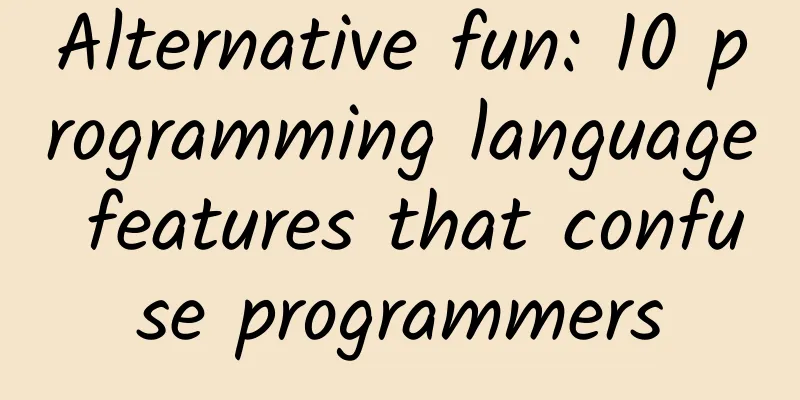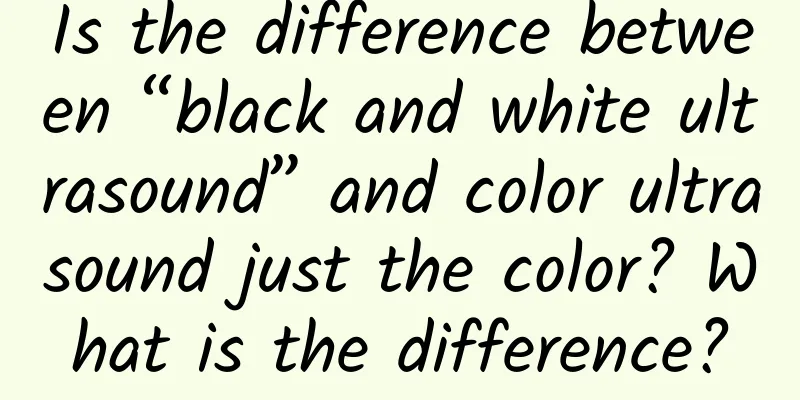Alternative fun: 10 programming language features that confuse programmers

|
Every language has its own unique features, whether it is a peculiar syntax, an uncommon function, or a non-standard execution method. Therefore, no matter whether you are a novice or an old hand, you will suddenly be intoxicated by a certain feature. This article summarizes 10 frequently mentioned "strange" features. 1. Javascript: + is a concatenation operator Problem description: In JS, the + sign is used between numbers and can be used for regular addition; but if it encounters a character, it can also be used as a character connector. For example: the result of '1' + 1 is 11. Cause Analysis: The fundamental reason is that JS is a weakly typed language. For example, Python also uses the + sign as a character connector, but because it is a strongly typed language, once it finds a character added to an integer, it will prompt that this is an error operation. Netizens' opinions: "The problem is that it's an unpredictable, forced, silent transition that's easy to miss." Anonymous "JS should throw an exception for this situation." crgwbr "Concatenating characters with + is a nightmare." Matteo Riva 2. Perl: Modules must return a TRUE value Problem description: In most cases, a Perl module must end with a 1; statement at the end, otherwise, if the return value of the last statement is not TRUE, the system will report an error. Cause Analysis: Perl modules contain initial code and subroutines. When the module file is loaded, Perl will determine whether the code is successfully executed based on whether it returns TRUE. Even if there is no initial code, Perl still expects the last statement to return TRUE, otherwise it will report an error. Netizens' opinions: "This usually makes me feel uneasy." Drew Hall "This is the most useless use." Schwern 3. C/C++: Three-letter word usage Problem description: For example, the system will automatically convert ??! to | when it sees it, and ??( to [. This can easily lead to unexpected results and greatly reduce the readability of the code. Cause Analysis: In the early days of programming, some special characters, such as curly brackets, could not be typed directly on the keyboard, so this indirect method was used. Netizens' opinions: "Even someone as knowledgeable as Google can't understand what is ??!??!" Isaac “Since the advent of the three-letter word in 1977, C has become obscure.” Martin Beckett 4. PHP: Case-Sensitive Processing Problem description: PHP is a bit confusing in its handling of upper and lower case letters, distinguishing between some and others. For example, it distinguishes between variable names and constant names, but not between function names, method names, and class names. Cause Analysis: It is likely an artifact of PHP's evolution from a collection of CGI scripts to a full-fledged programming language. Netizens' opinions: "This is why PHP programmers are used to using underscores for function names instead of camelCase."paperstreet7 "In PHP, everything is possible!" 5. Ruby: 0 as a truth value Problem description: In Ruby, the value 0 is equivalent to the value TRUE. This is a nightmare for programmers with a background in C and Python. Cause Analysis: Only the boolean values FALSE and nil are equivalent to FALSE, all others are equivalent to TRUE. 0 is treated the same as 1, 2, 3, etc. Netizens' opinions: "It's maddening, even though the intentions are good." Chris Lutz "0==true! My C language brain is about to collapse!" Kenny 6. Python: Hierarchical division by number of spaces Problem description: Unlike keywords or punctuation marks, PY uses indentation levels to divide the code into different levels to make it clear where each line of code is located. Incorrect number of spaces (or inconsistent number of spaces and placeholders) may cause the program to report an error. Cause Analysis: The intention of the PY authors is to make the code more readable, reduce unnecessary typing, and hope that programmers themselves should take responsibility for maintaining code clarity. Netizens' opinions: "To be honest, this is the fundamental reason why I stay away from PY." wazoox "If we really need a similar enforcement mechanism, are we really too lazy!" Joris Meys 7. C: Array indexes work like pointers Problem description: In C, a[i] and i[a] are interchangeable, and both expressions produce the same result. Cause Analysis: In C, there is no difference between arrays and pointers to memory blocks, that is: a[i] = *(a + i) = *(i + a) =i[a]. Netizens' opinions: "This has no value in a C code contest." "I think this is really revealing the core of C, pointers and dealing with memory more directly." Michael Neale 8. Perl's: Predefined variables Problem description: Perl has a very long list of special variables, and the names are very complicated (although there are corresponding long English words). Therefore, unless you are an experienced Perl developer, it is common to read the Perl documentation repeatedly. Cause Analysis: These variables have different meanings, such as process ID ($$), error message ($@), regular expression match ($^R). Netizens' opinions: "Very frustrating!" MatrixFrog "It could be good news for lean developers." "The problem with these variables is that they can't be found via Google!" malvim 9. JavaScript: Automatic semicolon insertion Problem description: JS uses semicolons as the end of statements and will automatically insert them even if the code is broken, which often leads to errors. Cause Analysis: Automation is meant to be convenient, especially for beginners. Netizens' opinions: "If we design language features with the user in mind as if they were idiots, we're going to run into problems." Rob Van Dam "Automatic semicolon insertion is one of the most annoying things about JS." fennec 10. Java: autoboxing and Integer caching Problem description: Java automatically converts primitive data to objects (autoboxing), for example, converting an int to an Integer object. By default, the cached Integer object has a value between -128 and 127. This can cause problems when using == to compare two Integer objects with the same value (TRUE between -128 and 127, and FALSE otherwise). Cause Analysis: The automatic boxing mechanism reduces the amount of code to type, while the Integer cache improves processing speed. Netizens' opinions: "Luckily I'm just a C# programmer." Will "This is not a bug, but rather gives us a reason to use primitive types (such as booleans) for number processing." Ravi Wallau |
<<: Introduction to the 5 most popular embedded databases for mobile development
>>: What are Google's 21 founding employees doing now?
Recommend
What are the conditions and steps required for Baidu V certification?
V certification definition: It presents the compr...
2019 Mobile Internet Self-discipline Whitelist Announced, AutoNavi Maps, Tencent and Others Selected
Recently, the China Anti-Network Virus Alliance (...
From Jack Ma's letter to shareholders, he gave a sneak peek into Alibaba's future
Dear Investors: When you open this Alibaba IPO pr...
Cocos brings "Adventure and Mining" to both native and web games
Big-budget, high-investment mobile games have alm...
Practical tips on field marketing cases: How do you spend the first hour in the field marketing battlefield?
16 years ago, Alibaba relied on a huge field sale...
Can coffee really help you lose weight? Huaxi doctors answer 6 truths about coffee
Recently, I have been I went to West China Hospit...
What impact will it have on Chinese mobile phone manufacturers as Google enters “retaliation” mode?
[[247942]] Introduction Since the beginning of th...
Data operation: How to use data analysis to improve user retention?
Acquiring users is only the first step, but retai...
Can eating rice like this help you lose weight? Are you tempted?
I heard that cooling down cooked rice, steamed bu...
How can information flow control page design and reduce advertising waste?
A design that can stimulate users' desire to ...
Chengdu New Tea Selection Studio is highly praised by everyone who has visited it
Appointment arrangements for Chengdu New and Tend...
OPPO Find7 Lite Edition Review
The OPPO Find 7 released this time includes a sta...
Some of the best tricks for iOS development
Some tips for iOS What should I do if TableView d...
Marine Life Illustrations | The unicorn arm playing the violin is so cool~
Source: Zhejiang Ocean University...
How to take advantage of the popularity? I have summarized 19 techniques!
Hot spots are the fulcrum for operators to pry th...









